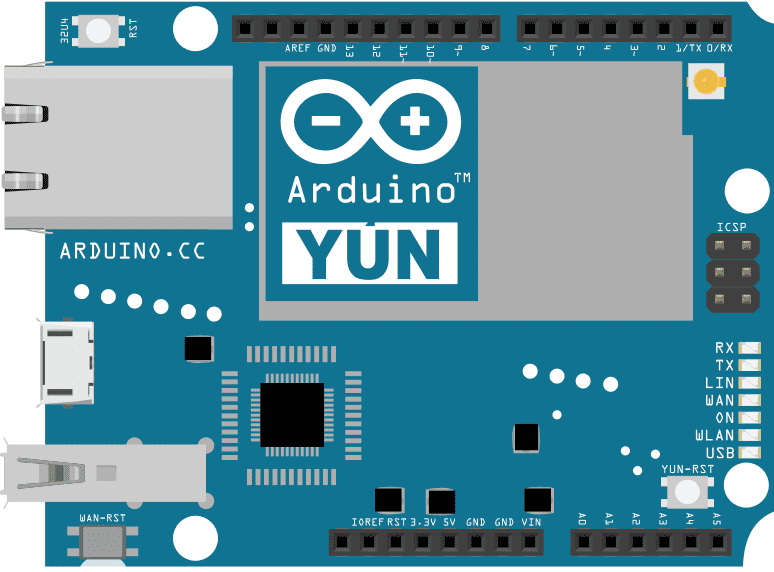Console Pixel
An example of using a Yún device to receive data on the Console from a computer. In this case, the Yún device turns the on-board LED connected to digital pin 13 on when it receives the character 'H', and off when it receives the character 'L'.
The Console, based on Bridge, enables you to send information between the Yún device and a computer just as you would with the serial monitor, but wirelessly. It creates a secure connection between the Yún device and your computer via SSH.
To see the Console, make sure your Yún device and computer are in the same wireless network. Pick your Yún's name and IP address in the Port menu in the Arduino Software (IDE) then open the Serial Monitor. You can also see it by opening a terminal window and typing ssh root@ yourYúnsName.local 'telnet localhost 6571' then pressing enter. When prompted for the password, enter it.
Hardware Required
Yún board or shield
computer and Yún device on the same wireless network
Circuit
There is no circuit for this example.

image developed using Fritzing. For more circuit examples, see the Fritzing project page
Code
Include the Console library, which inherits from Bridge.
#include <Console.h>
Create variables and name the pin to write to, and another one to store the incoming byte from the Console.
const int ledPin = 13;
char incomingByte;In setup() initialize the Bridge and Console, and wait for a connection to the Console port.
void setup() {
Bridge.begin();
Console.begin();
while(!Console);Once connected, print out some basic instructions to the Console window with Console.println() and set the LED pin as an output.
Console.println("type H or L to turn pin 13 on or off");
pinMode(ledPin, OUTPUT);
}In loop(), check to see if there is information from the Console. If there is, read the oldest byte in the buffer and echo it back to the Console window.
void loop() {
if (Console.available() > 0) {
incomingByte = Console.read();
Console.println(incomingByte);If the incoming byte is a capital "H", turn the LED on, if it is a "L", turn the LED off.
if (incomingByte == 'H') {
digitalWrite(ledPin, HIGH);
}
if (incomingByte == 'L') {
digitalWrite(ledPin, LOW);
}
}
}The complete sketch is below :
/*
Console Pixel
An example of using YunShield/Yún board to receive data from the
Console on the Yún. In this case, the board turns on an LED when
it receives the character 'H', and turns off the LED when it
receives the character 'L'.
To see the Console, pick your Yún's name and IP address in the Port menu
then open the Port Monitor. You can also see it by opening a terminal window
and typing
ssh root@ yourYunsName.local 'telnet localhost 6571'
then pressing enter. When prompted for the password, enter it.
The circuit:
* LED connected from digital pin 13 to ground
created 2006
by David A. Mellis
modified 25 Jun 2013
by Tom Igoe
This example code is in the public domain.
http://www.arduino.cc/en/Tutorial/ConsolePixel
*/
#include <Console.h>
const int ledPin = 13; // the pin that the LED is attached to
char incomingByte; // a variable to read incoming Console data into
void setup() {
Bridge.begin(); // Initialize Bridge
Console.begin(); // Initialize Console
// Wait for the Console port to connect
while (!Console);
Console.println("type H or L to turn pin 13 on or off");
// initialize the LED pin as an output:
pinMode(ledPin, OUTPUT);
}
void loop() {
// see if there's incoming Console data:
if (Console.available() > 0) {
// read the oldest byte in the Console buffer:
incomingByte = Console.read();
Console.println(incomingByte);
// if it's a capital H (ASCII 72), turn on the LED:
if (incomingByte == 'H') {
digitalWrite(ledPin, HIGH);
}
// if it's an L (ASCII 76) turn off the LED:
if (incomingByte == 'L') {
digitalWrite(ledPin, LOW);
}
}
}See Also
Bridge Library - Your reference to the Bridge Library
Bridge - Simple REST style calls to access analog and digital pins
Console Ascii Table - A complete ASCII table printed to the Console
Console Read - Read data coming from bridge using the Console.read() function
Data Logger - Log data from three analog sensors to an SD card.
File Write - How to write file into the Yún filesystem.
Http Client - A basic HTTP client that connects to the internet and downloads content.
Http Client Console - HTTP client that connects, downloads content and shows it using WiFi and Console.
Mailbox Read Message - How to read the messages queue, called Mailbox, using the Bridge library.
Process - How to run linux processes using an Yún.
Remote Due Blink - How to upload remotely a sketch on DUE boards.
Shell Commands - How to run linux shell commands using a Yún.
Temperature Web Panel - How to serve data from an analog input via the Yún's built-in webserver.
Time check - Gets the time from Linux via Bridge then parses out hours, minutes and seconds.
WiFi Status - Prints information about the status of your wifi connection.
Yún First Configuration - Easily configure your Yún device using Serial Monitor and USB port.
Serial Terminal - Use the Yún's 32U4 processor as a serial terminal for the Linux side on the Yún.
Last revision 2016/05/25 by SM